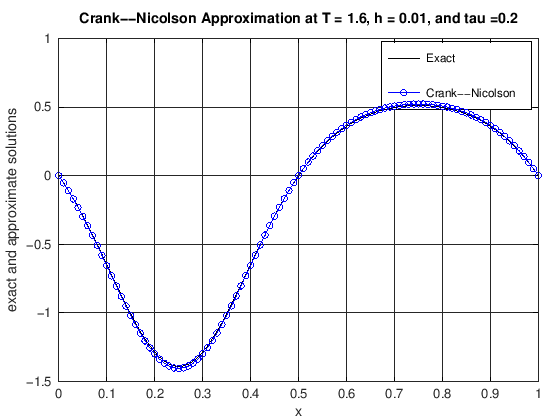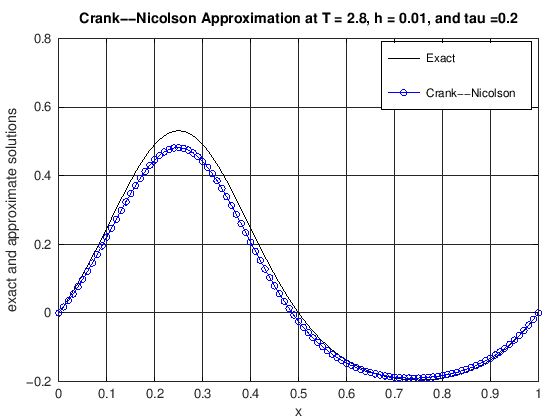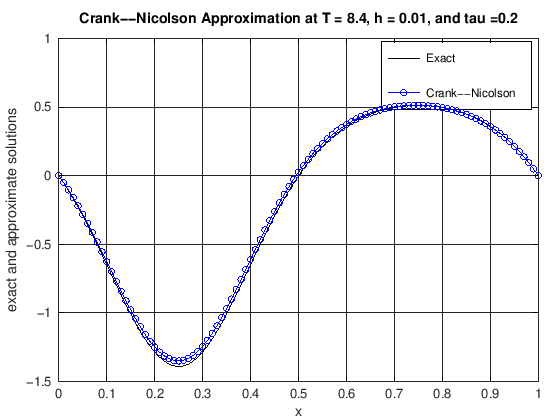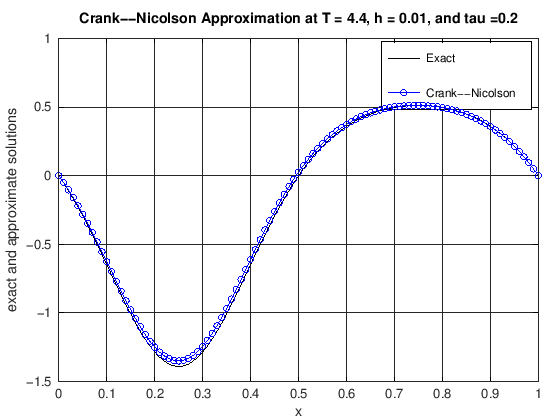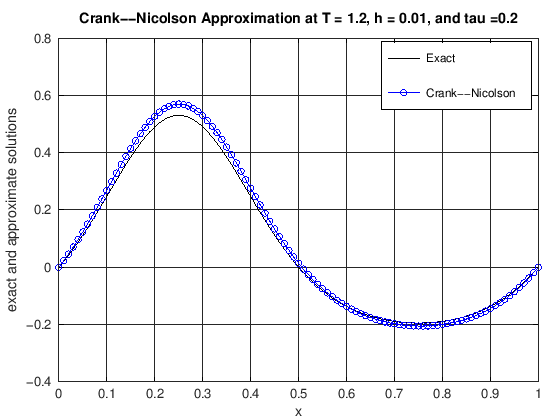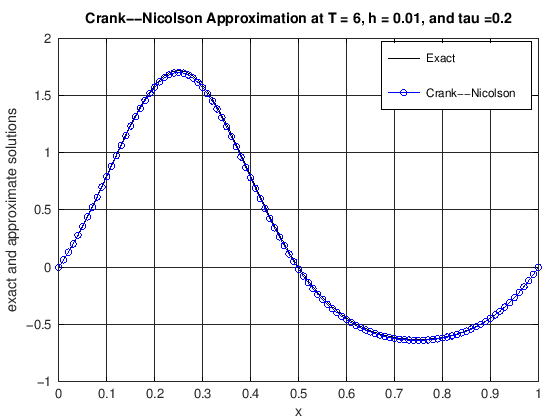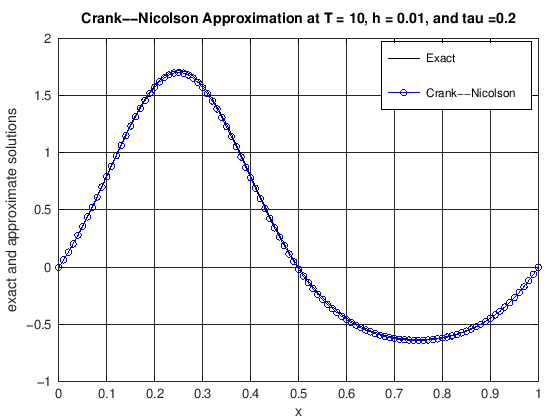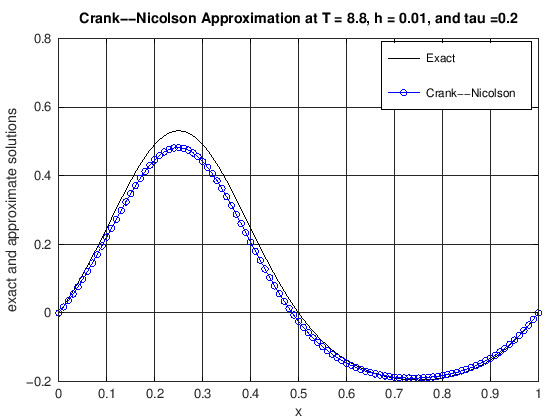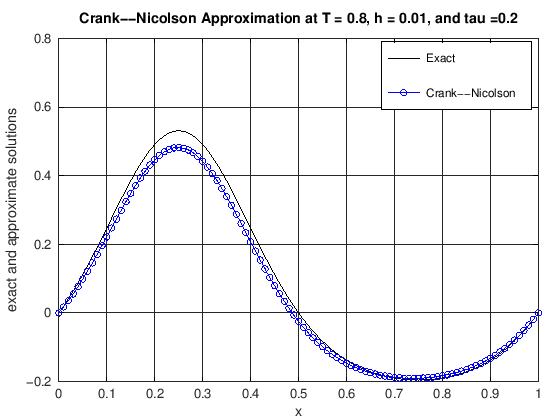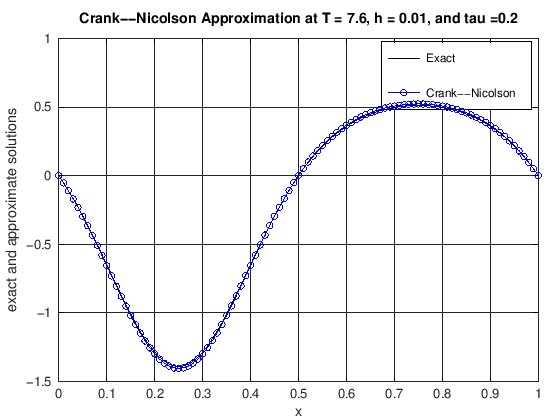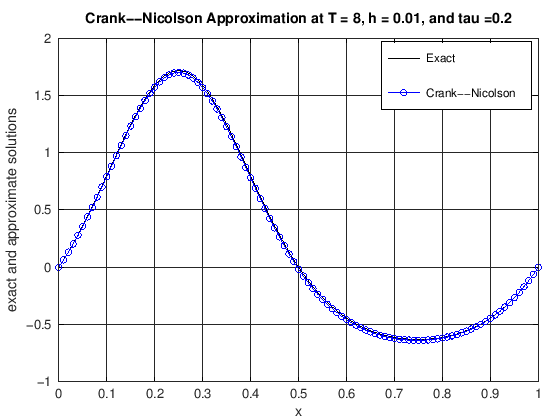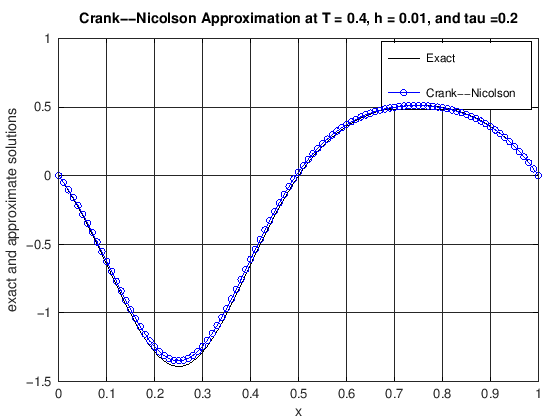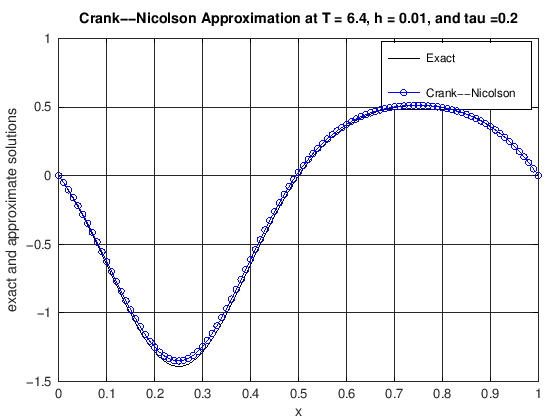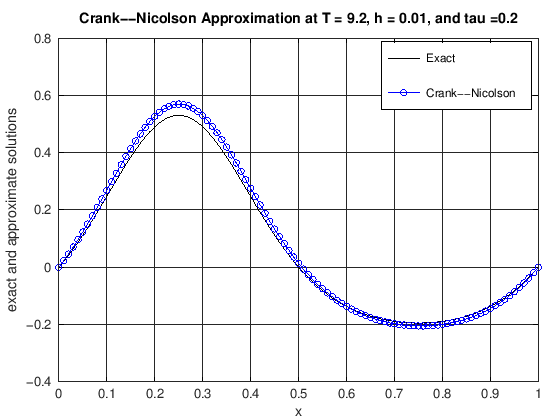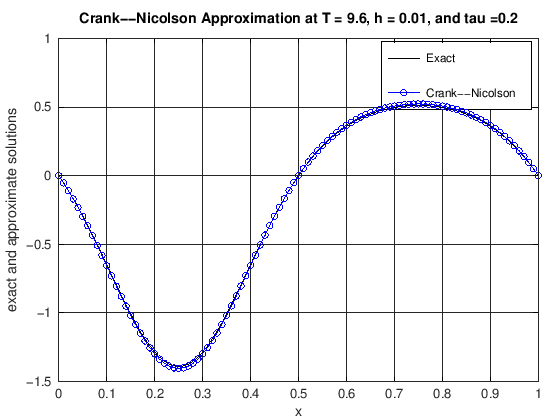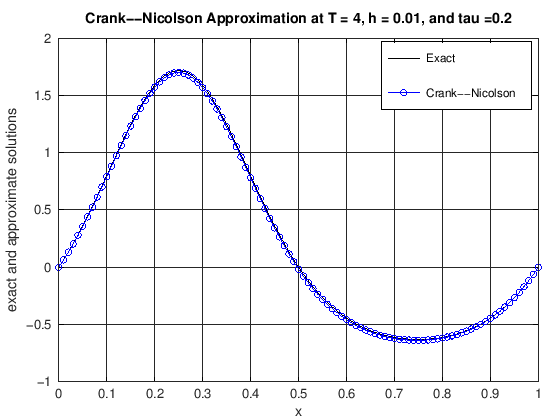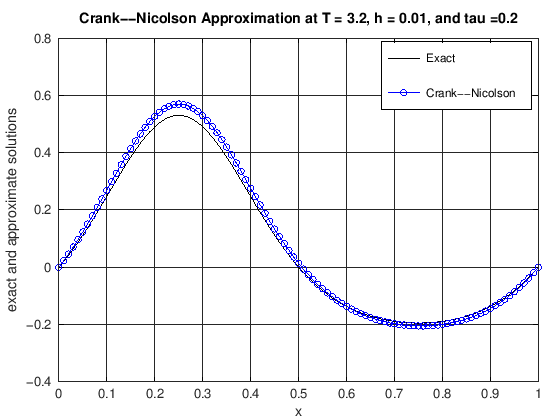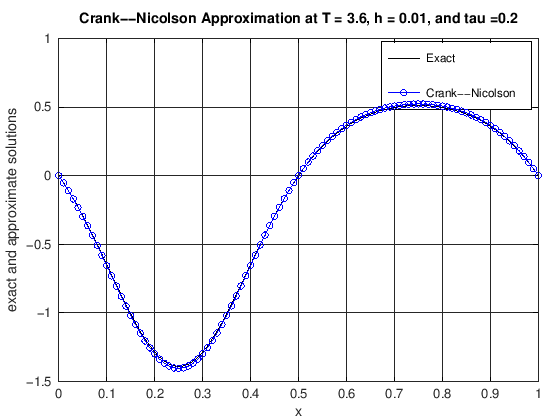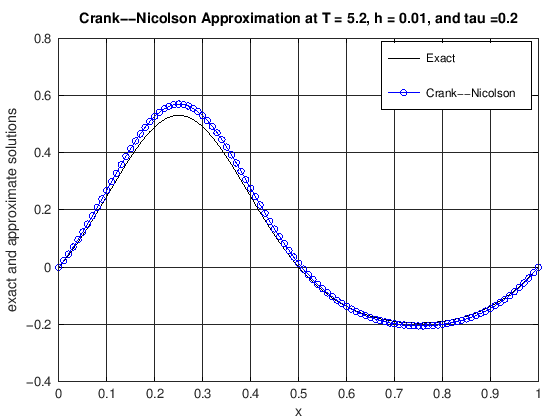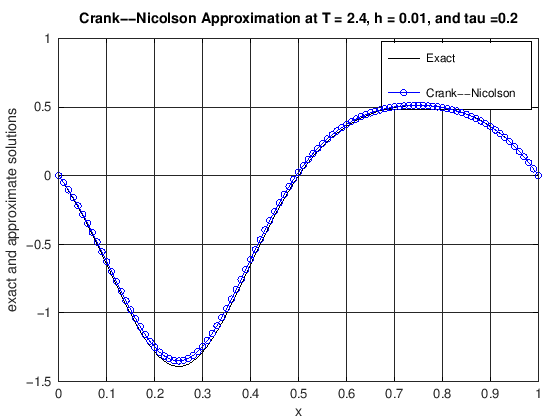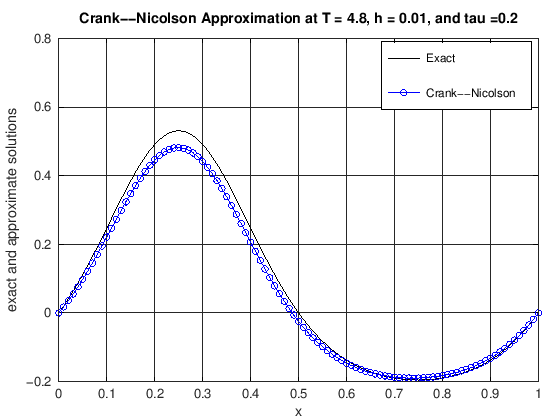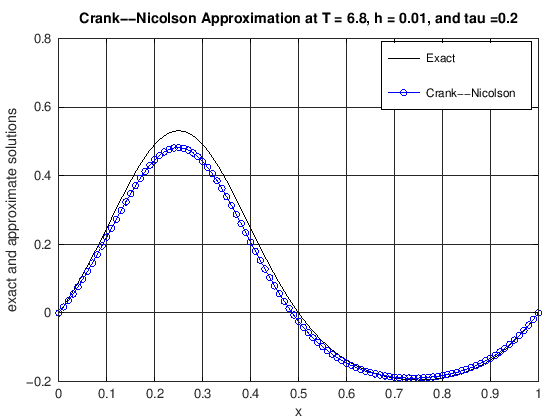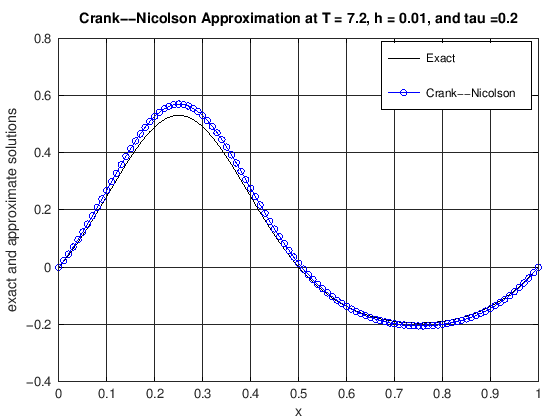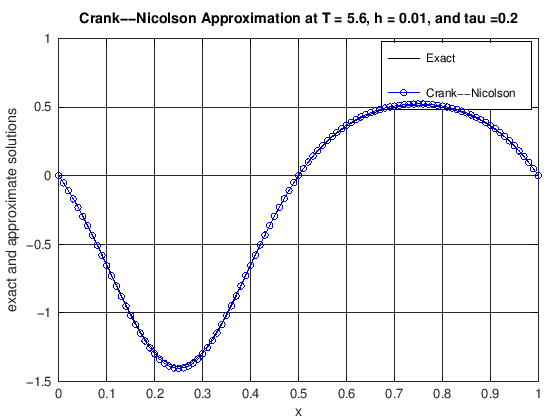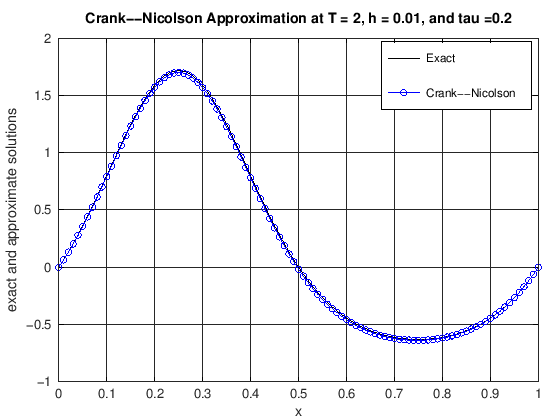14. DiffusionCrankNic.m#
function [x, err] = TriDiagonal(a, b, c, f)
% Solution of a linear system of equations with a tridiagonal
% matrix.
%
% a(k) x(k-1) + b(k) x(k) + c(k) x(k+1) = f(k)
%
% with a(1) = c(n) = 0.
%
% Input
% a(1:n), b(1:n), c(1:n) : the coefficients of the system
% matrix
% f(1:n) : the right hand side vector
%
% Output
% x(1:n) : the solution to the linear system of equations, if
% no division by zero occurs
% err : = 0, if no division by zero occurs
% = 1, if division by zero is encountered
n = length(f);
alpha = zeros(n, 1);
beta = zeros(n, 1);
err = 0;
if abs(b(1)) > eps(b(1))
alpha(1) = -c(1) / b(1);
beta(1) = f(1) / b(1);
else
err = 1;
return;
end
for k = 2:n
denominator = a(k) * alpha(k - 1) + b(k);
if abs(denominator) > eps(denominator)
alpha(k) =- c(k) / denominator;
beta(k) = (f(k) - a(k) * beta(k - 1)) / denominator;
else
err = 1;
return;
end
end
if abs(a(n) * alpha(n - 1) + b(n)) > eps(b(n))
x(n) = (f(n) - a(n) * beta(n - 1)) / (a(n) * alpha(n - 1) + b(n));
else
err = 1;
return;
end
for k = n - 1:-1:1
x(k) = alpha(k) * x(k + 1) + beta(k);
end
end
warning: using the gnuplot graphics toolkit is discouraged
The gnuplot graphics toolkit is not actively maintained and has a number
of limitations that are unlikely to be fixed. Communication with gnuplot
uses a one-directional pipe and limited information is passed back to the
Octave interpreter so most changes made interactively in the plot window
will not be reflected in the graphics properties managed by Octave. For
example, if the plot window is closed with a mouse click, Octave will not
be notified and will not update its internal list of open figure windows.
The qt toolkit is recommended instead.
function frc = fForcing(N, t)
%
% Constructs the forcing term:
%
% Input
% N : to compute the mesh size
% t : the current time at the time interval midpoint
%
% Output
% f(1:N-1) : the array of values of the forcing function
%
frc = zeros(1, N - 1);
h = 1.0 / N;
for i = 1:N - 1
x = i * h;
tpx = 2.0 * pi * x;
tpt = 2.0 * pi * t;
frc(i) = 2.0 * pi * sin(tpt) * (1.0 - exp(sin(tpx))) ...
+ 4.0 * pi * pi * cos(tpt) * exp(sin(tpx)) ...
* (sin(tpx) - cos(tpx) * cos(tpx));
end
end
function ue = uExact(N, t)
%
% Constructs the exact solution:
%
% Input
% N : to compute the mesh size
% t : the current time
%
% Output
% ue(1:N+1) : the array of values of the exact solution
%
ue = zeros(1, N + 1);
h = 1.0 / N;
for i = 0:N
x = i * h;
tpx = 2.0 * pi * x;
tpt = 2.0 * pi * t;
ue(i + 1) = cos(tpt) * (exp(sin(tpx)) - 1.0);
end
end
function [error] = DiffusionCrankNic(finalT, N, K, numPlots)
%
% This function computes numerical approximations to solutions
% of the linear diffusion equation
%
% u_t - u_xx = f(x,t)
%
% using the Crank-Nicolson (CN) method on the domain [0,1]. The
% forcing function, f, and the intial conditions are constructed
% so that the true solution is
%
% u(x,t) = cos(2*pi*t)*(exp(sin(2*pi*x))-1.0).
%
% This can be easily modified.
%
% Input
% finalT : the final time
% N : the number of spatial grid points in [0,1]
% K : the number of time steps in the interval [0,finalT]
% numPlots : the number of output frames in the time interval
% [0,finalT]. numPlots must be a divisor of K.
%
% Output
% error: the max norm error of the CN scheme at t = finalT
%
error = 0.0;
if N > 0 && N - floor(N) == 0
h = 1.0 / N;
else
display('Error: N must be a positive integer.')
return
end
if (K > 0 && K - floor(K) == 0) && finalT > 0
tau = finalT / K;
else
display('Error: K must be a positive integer, and')
display(' finalT must be positive.')
return
end
mu = tau / (2.0 * h * h);
x = 0:h:1.0;
uoCN(1:N + 1) = uExact(N, 0.0);
if mod(K, numPlots) == 0
stepsPerPlot = K / numPlots;
else
display('Error: numPlots is not a divisor of K.')
return
end
%
% Define the tridiagonal system matrix to be inverted:
%
a(1) = 0.0;
a(2:N - 1) = -mu;
b(1:N - 1) = 1.0 + 2.0 * mu;
c(1:N - 2) = -mu;
c(N - 1) = 0.0;
%
% Main time loop:
%
for k = 1:numPlots
for j = 1:stepsPerPlot
kk = (k - 1) * stepsPerPlot + j;
currTime = tau * (kk);
lastTime = tau * (kk - 1.0);
f(1:N - 1) = tau * (fForcing(N, currTime) ...
+fForcing(N, lastTime)) / 2.0;
for ell = 1:N - 1
rhs(ell) = f(ell) + uoCN(ell + 1) + mu * (uoCN(ell) ...
-2.0 * uoCN(ell + 1) + uoCN(ell + 2));
end
[uCN(2:N), err] = TriDiagonal(a, b, c, rhs);
uCN(1) = 0.0;
uCN(N + 1) = 0.0;
uoCN = uCN;
end
hf = figure(k);
clf
plot(x, uExact(N, currTime), 'k-', x, uCN, 'b-o')
grid on,
xlabel("x");
ylabel('exact and approximate solutions');
title(['Crank--Nicolson Approximation at T = ', ...
num2str(currTime), ', h = ', num2str(h), ...
', and tau =', num2str(tau)]);
legend("Exact", "Crank--Nicolson")
set(gca, "xTick", 0:0.1:1)
s1 = ['000', num2str(k)];
s2 = s1((length(s1) - 3):length(s1));
s3 = ['OUT/diff', s2, '.pdf'];
%exportgraphics(gca, s3)
end
error = max(abs(uExact(N, currTime) - uCN));
end
finalT = 10;
N = 100;
K = 50;
numPlots = 25;
[error] = DiffusionCrankNic(finalT, N, K, numPlots)
error = 0.019031
